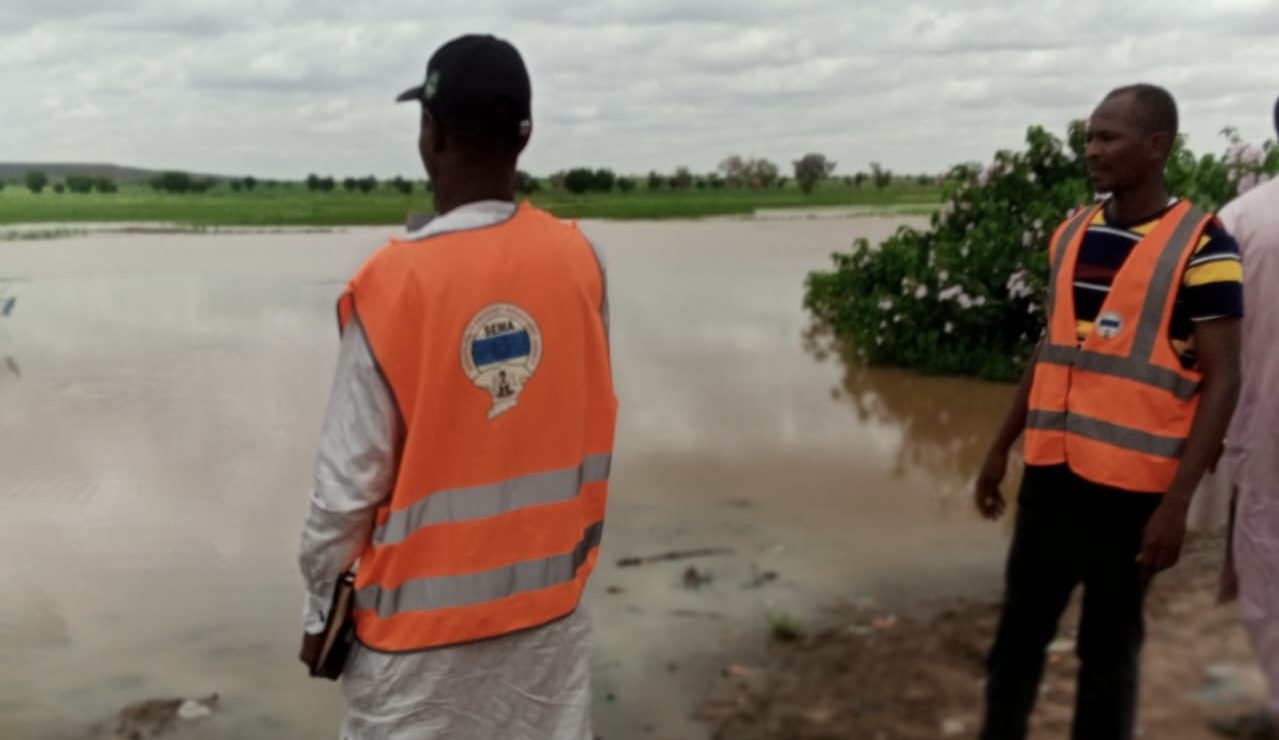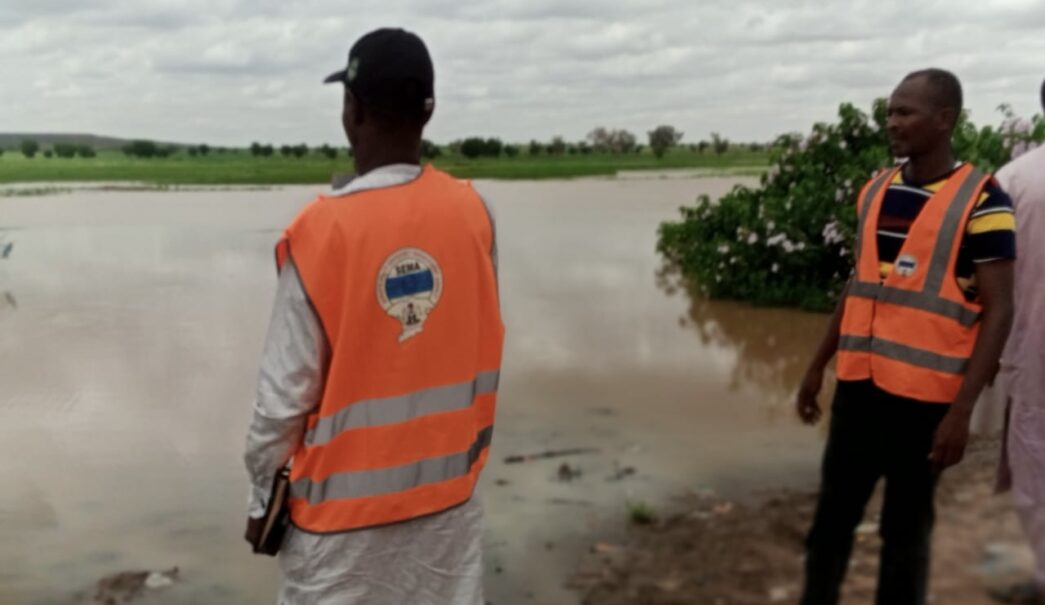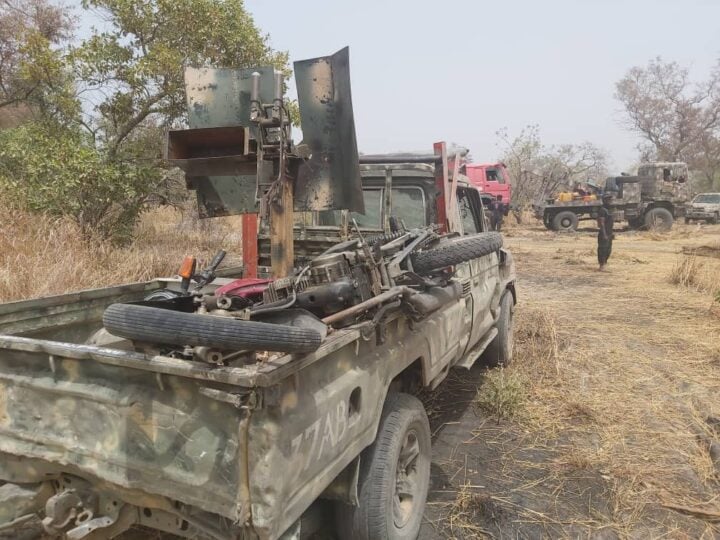NEMA officials at a flooded farm
BY ABDULHAMID ABDULLAHI ALIYU
In yet another reminder of Nigeria’s vulnerability to climate shocks, the Nigerian Meteorological Agency (NiMet) has issued a fresh flood alert affecting 20 states across the country. From Sokoto to Bayelsa, Delta to Kaduna, and Lagos to Yobe, millions of residents in high-risk areas have begun fleeing or taking preventive steps, while emergency management agencies race against time to prevent a repeat of past tragedies.
The warning, coming in July at the peak of Nigeria’s rainy season, forecasts intense rainfall in the weeks ahead—an event that could trigger flash floods, landslides, and mass displacement. Already, parts of Lagos, Yobe, Ondo, Benue, and Imo states have begun witnessing early signs of flooding, raising anxiety and putting public preparedness efforts to the test.
In the eye of this looming storm is the National Emergency Management Agency (NEMA), which has intensified its pre-disaster strategy in partnership with state emergency agencies. Over the past few weeks, the agency has supported community sensitisation campaigns, mapped out temporary shelters, coordinated inter-agency response frameworks, and closely monitored vulnerable zones through real-time disaster surveillance.
Advertisement
Speaking during a recent stakeholder briefing, NEMA’s director-general, Mrs Zubaida Umar, reiterated the need for state and local governments to go beyond issuing alerts and activate their flood mitigation plans. “Preparedness is not a choice. It is the only guarantee against irreversible loss,” she noted. Her message captures a reality that has plagued Nigeria for over a decade: early warnings often fail to inspire early action.
From the 2012 flood disaster that displaced over two million people, to the more recent 2022 crisis that killed over 600 and affected 4.4 million Nigerians, the patterns are familiar—and sobering. The annual flood season has become a cycle of warnings, delayed responses, avoidable deaths, and post-disaster relief efforts.
This year, however, there is cautious hope that lessons from the past are prompting swifter action. In Kaduna, for instance, the state emergency agency (KADSEMA) has launched safe haven centres across flood-prone LGAs, in partnership with NEMA, the Federal Fire Service, and others. Dredging of the River Kaduna has begun, and awareness campaigns are ongoing across radio and community platforms.
Advertisement
In Adamawa state, the government has released ₦700 million to support preemptive evacuation, warehousing of relief materials, and sensitisation in at least 15 vulnerable local government areas. “We don’t want to be caught unprepared again,” says Celina Laori, executive secretary of the state’s emergency agency.
Elsewhere, NEMA’s field offices are working closely with state authorities to mobilise communities. In Imo, the agency has carried out public sensitisation and positioned ambulances and emergency supplies ahead of potential displacement. In Edo and Jigawa, residents in floodplains have begun self-evacuating following community engagements supported by emergency officials.
But beyond government actions, ordinary Nigerians are taking charge of their own safety. In Lekki, Lagos, residents like Olumide Samuel have moved their families out ahead of expected flooding. “We do this every year—it’s not ideal, but it’s better than waiting to be rescued,” he said. In Benue, parents have relocated their children from vulnerable areas even as water levels on the River Benue slowly rise.
Despite this, concerns persist about the capacity of some states to manage what lies ahead. A 2022 report showed that over ₦620 billion in ecological funds has been allocated to state governments over the past decade, yet many states lack sustainable flood defence infrastructure. Environmentalist Mayokun Iyaomolere argues that while awareness has improved, it is not backed by adequate investment or enforcement. “Drainages are still blocked. Buildings still rise on waterways. We’re preparing with buckets when we need bulldozers,” he said.
Advertisement
Part of the challenge lies in the intersection between environmental degradation and urban planning failures. Deforestation, sand dredging, and the uncontrolled construction of buildings on floodplains have eroded the natural barriers that once absorbed rainfall. In many cities, rapid urbanisation has outpaced infrastructure, leaving gutters choked with refuse and floodwaters with nowhere to go.
To bridge this gap, NEMA has not only issued advisories but also strengthened its simulation exercises and inter-agency coordination. Earlier this year, mock flood drills were held in Anambra and Kano states, simulating real-time evacuations and testing communication chains. The goal is to make preparedness a routine rather than a reaction.
Nonetheless, simulation alone is not a substitute for policy reform. Experts insist that Nigeria must move beyond warnings and develop a national flood resilience plan—one that prioritises sustainable drainage, the relocation of communities in high-risk zones, and long-term investment in ecological restoration.
For now, the battle is one of time and commitment. Floods are not a surprise event in Nigeria—they are a certainty. What remains uncertain is how well-prepared the nation is to confront them.
Advertisement
As rivers swell and the skies darken, millions of Nigerians await what may come. But unlike in years past, there is a growing realisation—within government agencies like NEMA, state actors, and among citizens themselves—that early warnings must finally lead to early action.
Abdulhamid Abdullahi Aliyu writes on disaster management, humanitarian affairs, and national development.
Advertisement
Views expressed by contributors are strictly personal and not of TheCable.









